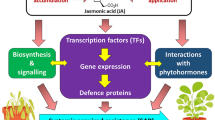Abstract.
Two responses to elicitins are described in cultivars of radish (Raphanus sativus L.). Type I, exhibited by the cultivar Daikon, is characterised by wilting and desiccation within 24 h of elicitin application and was previously reported as the sensitive response (S. Kamoun et al. 1993, Mol Plant-Microbe Interact 6: 15–25). At 1 μg elicitin · g−1 FW radish tissue, symptoms appeared after 8 h, a sensitivity comparable to that shown by tobacco to β elicitins (J.-C. Pernollet et al., 1993, Physiol Mol Plant Pathol 42: 53–67; S. Kamoun et al., 1993, Mol Plant-Microbe Interact 6: 15–25). Elicitin failed to induce these symptoms in the cultivar White Icicle, even at 100 μg · g−1 FW of tissue. However, a different response (Type II) with symptoms resembling senescence appeared in White Icicle after 48 h and were fully developed by 72 h. The Type II response was induced at levels of elicitin above 0.3 μg · g−1 FW. Elicitin-treated Daikon leaves held at 100% relative humidity, rather than ambient (50–60%) did not wilt and by 72 h displayed Type II symptoms. When treated Daikon leaves were removed to ambient humidity at any time during the latent period, they developed Type I symptoms within 2 h. Although Type I symptoms were suppressed in Daikon at high humidity, there was no indication that leaf diffusion resistance or plant water conductance were affected. Protoplasts from the cultivar Daikon responded to elicitin by H+ uptake and K+ release, with maximal response at 300 pM. The response was eliminated by K252a or staurosporine. Daikon protoplasts also showed transient uptake/secretion of Ca2+ on elicitin addition. Protoplasts from White Icicle gave neither of these responses. Both Daikon and White Icicle phenotypes could be transferred to progeny of Daikon-White Icicle crosses and in the F2 generation three phenotypes, including a null, segregated. Only those F2 plants which exhibited the Daikon phenotype produced protoplasts which responded to elicitin.
Similar content being viewed by others
Author information
Authors and Affiliations
Additional information
Received: 13 May 1997 / Accepted: 27 August 1997
Rights and permissions
About this article
Cite this article
Keizer, D., Schuster, B., Grant, B. et al. Interactions between elicitins and radish Raphanus sativus . Planta 204, 480–489 (1998). https://doi.org/10.1007/s004250050282
Issue Date:
DOI: https://doi.org/10.1007/s004250050282




